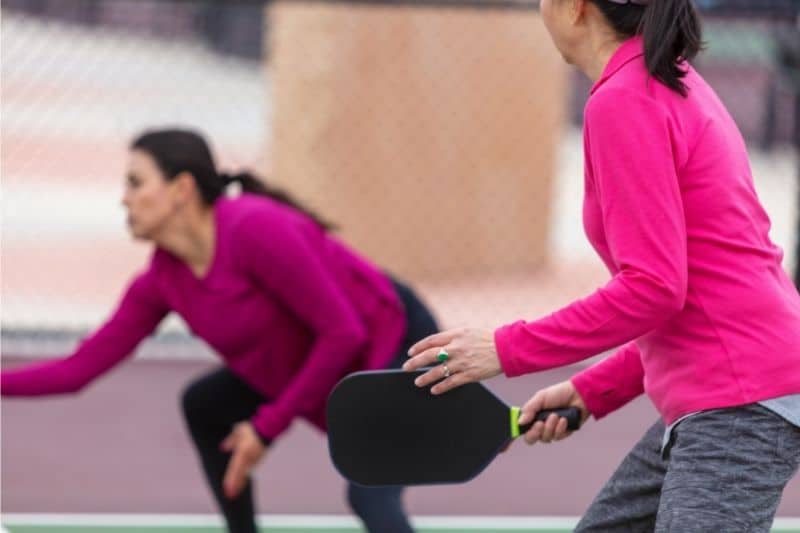
Dinking is one of the most important shots in pickleball to know and use. In fact, it is a shot that is crucial for leveling up your pickleball game. As simple as dinking may be, it can often create the most unforced error in a game. Here are the top six common pickleball dinking mistakes that you can avoid.
Top Six Common Pickleball Dinking Mistakes
Not Bending Your Knees
Dinking in pickleball means softly hitting the ball to your opponent’s non-volley zone so that the ball clears the net but bounces low. A low ball means the maximum height of the bounce will be close to the ground. To return a low ball requires that you bend your knees in order to be able to reach and get closer to the ball.
You want your eyes to be as close to the ball so your paddle is in contact with the ball at its sweet spot. Bending your knees is important not just for dinking but for so many pickleball shots. If your legs are standing stiff, your legs are not ready to move with the ball as it is passed back and forth. This can create a gap between you and your partner if they’re moved wide toward the sideline.
Overreaching Instead Of Moving Your Legs
Along with not bending knees enough, overreaching is another common pickleball dinking mistake that you may see over and over. Moving your legs laterally is so important when all four players are at the kitchen line. The ball may be placed in different spots within the kitchen.
As mentioned earlier, you want to be moving with the ball instead of overreaching. You also want your opponents to be moving out of their stable position to create gaps. When you overreach, you can create more opportunities for unforced errors such as whiffing the ball with the tip of your paddle, accidentally propping the ball up, or hitting the ball into the net.
By moving your legs and eliminating overreaching altogether, you’re minimizing unforced errors on your part at the kitchen line.
Being Too Fancy With Your Shots
Those that come from other racket sports such as tennis or table tennis love to bring certain shots from those sports. You may see this in a lot of 3.0 to 3.5 rec players who may have not figured out pickleball strategies. Dinking should be kept simple and clean without the need for fancy slices or spins. Especially at the lower levels where consistency is more important.
You want to go for high-percentage shots, shots that are most likely going to keep the ball in play. When you’re trying to be fancy with your shots instead of going for clean, consistent shots, you may run into more unforced errors.
Not Dinking With Purpose
Dinking is a shot with many different purposes. It can be an offensive or defensive shot when you’re able to control placement. As an offensive shot, you can target closer to the kitchen line towards your opponent’s feet. This forces your opponent to move back or return a weaker dink where it may become attachable for you or your partner.
You can also place the ball wide towards the sideline or deeper back to your opponent’s backhand. You may see the ball returned to the net if your opponent is not diligent about moving. Or they may inadvertently prop the ball up while moving to return the ball.
As a defensive shot, you can place the dink closer to the net so that it is out of your opponent’s reach. This makes the ball unattackable. A defensive dink is a great strategy if your partner is far back from the non-volley zone and you need to buy time for them to get to the kitchen line.
Losing Patience
Perhaps one of the most common pickleball dinking mistakes you may often see is losing patience while dinking. Dinking is a pickleball strategy that involves moving your opponents around, looking for gaps, and creating opportunities for attack or your opponents to make unforced errors.
It can be easy to lose your patience when the dink rally gets too long. You don’t want to be the player that loses their patience and hits a low, unattackable ball into the net. Or prop up the ball for your opponent to put it away. Even as a better player, you can lose a point to less experienced opponents just by losing your patience when dinking.
Not Looking For Opportunities To Attack
Many people tend to forget that dinking is a great way to bait opportunities for attack. As mentioned earlier, dinking can be defensive and offensive. When all players are at the net in a dinking battle, you should be ready at all times to attack a high ball. A high ball is one with just enough bounce that is higher than your knees or the net.
You should also be ready to block an attack if you or your partner has either created an attackable ball by accident or baited an attack to counter. You can bait an attack by adding pace to the dink so that it will come back attackable.
Or so that your opponent attacks the ball but you’re prepared to do a stronger counterattack. Dinking can be a way to put away the ball when you start looking for specific balls to attack.
Summary
So many people can overlook dinking as a shot that needs to be practiced often. Dinking is not the sexiest shot nor is it exciting that you may even find rec players who refuse to learn how to use it properly. The result is making dinking mistakes that can cost the game. But when used correctly, dinking can create many opportunities for winning shots.
Read Next: Pickleball Strategies: Why Dinking Is So Important In Pickleball

